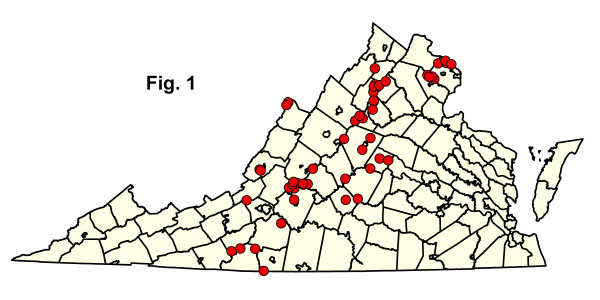
 Sở Bảo Tồn và Giải Trí
Sở Bảo Tồn và Giải Trí Bảo Tồn. Bảo Vệ. Tận Hưởng.
 Sở Bảo Tồn và Giải Trí
Sở Bảo Tồn và Giải Trí  Mục lục
Mục lụcRừng phù sa suối nhỏ miền núi Piedmont
Các khu rừng trong nhóm này chiếm giữ môi trường sống tạm thời bị ngập dọc theo các dòng suối nhỏ hơn, nơi có các dạng địa hình phù sa riêng biệt (ví dụ như đê, ruộng bậc thang, đầm lầy) xuất hiện ở quy mô rất nhỏ. Những cộng đồng này được tìm thấy dọc theo nhiều dòng suối và những con sông nhỏ nhất trên khắp vùng Piedmont và các thung lũng vùng núi; những khu rừng mọc dọc theo những con sông nhỏ có độ dốc tương đối cao và những dòng suối lớn trên núi trước đây được công nhận là một nhóm riêng biệt ("rừng phù sa miền núi") nhưng hiện đã được hợp nhất thành một nhóm rộng hơn. Đất đai, chế độ ngập lụt và thành phần thực vật rất đa dạng. Môi trường sống thường bao gồm các đồng bằng ngập lụt hẹp với đất phù sa mịn đến thô; phù sa dạng đá cuội hoặc sỏi và lòng suối đá là điển hình ở trong và dưới chân núi.
Characteristic trees in the Piedmont and mountain valleys include sycamore (Platanus occidentalis), eastern boxelder (Acer negundo var. negundo), American elm (Ulmus americana), green ash (Fraxinus pennsylvanica), river birch (Betula nigra), red maple (Acer rubrum), yellow buckeye (Aesculus flava; southwestern Virginia only), black walnut (Juglans nigra), tulip-tree (Liriodendron tulipifera), and black willow (Salix nigra). Shrubs include spicebush (Lindera benzoin var. benzoin), black haw (Viburnum prunifolium), American hornbeam (Carpinus caroliniana), and American hazelnut (Corylus americana). Herbaceous composition varies greatly with site conditions and geography, but generally includes such characteristic species as mistflower (Conoclinium coelestinum), hollow joe-pye weed (Eutrochium fistulosum), thin-leaved sunflower (Helianthus decapetalus), cardinal flower (Lobelia cardinalis), great blue lobelia (Lobelia siphilitica), American bugleweed (Lycopus americanus), Virginia bugleweed (Lycopus virginicus), fringed loosestrife (Steironema ciliatum), sensitive fern (Onoclea sensibilis var. sensibilis), fall phlox (Phlox paniculata), hispid hedge-nettle (Stachys hispida), tall meadow-rue (Thalictrum pubescens), and wingstem (Verbesina alternifolia) .
Along montane floodplains, most of the lower, streamside terraces are probably flooded briefly at least annually. More powerful, catastrophic floods occur at irregular intervals and may be very destructive to stream channels and vegetation. The forests of these habitats are characterized by a mixture of bottomland and mesophytic species. Among the most common trees are sycamore (Platanus occidentalis), eastern hemlock (Tsuga canadensis), eastern white pine (Pinus strobus), white oak (Quercus alba), birches (Betula alleghaniensis and Betula lenta var. lenta), and tulip-tree (Liriodendron tulipifera). Other trees that may be locally important are American beech (Fagus grandifolia), yellow buckeye (Aesculus flava), red maple (Acer rubrum), American elm (Ulmus americana) and, in far southwestern Virginia only, sweetgum (Liquidambar styraciflua). Understory shrubs may include American hornbeam (Carpinus caroliniana), great rhododendron (Rhododendron maximum), smooth alder (Alnus serrulata), willows (Salix sericea and Salix nigra), and witch hazel (Hamamelis virginiana var. virginiana). Montane floodplain habitats are relatively well drained and support a great variety of mostly mesophytic herbaceous species such as hog-peanut (Amphicarpaea bracteata), common jack-in-the-pulpit (Arisaema triphyllum ssp. triphyllum), green-and-gold (Chrysogonum virginianum var. virginianum), and golden ragwort (Packera aurea). More frequently flooded and hydric microhabitats along the stream channels, however, usually support some wetland species, e.g., twisted sedge (Carex torta), nodding sedge (Carex gynandra), fowl mannagrass (Glyceria striata var. striata), hooked buttercup (Ranunculus recurvatus var. recurvatus), and marsh blue violet (Viola cucullata).
So với Rừng ngập lụt miền núi/Piedmont, các cộng đồng thuộc nhóm này chiếm các vùng đồng bằng ngập lụt nhỏ hơn, có địa hình không đồng nhất hơn và có thảm thực vật đa dạng thấp hơn. Chúng ít được ghi chép ở Virginia và hầu hết đều trong tình trạng xuống cấp do tình trạng khai hoang, chăn thả gia súc, lũ lụt thảm khốc và cỏ dại xâm lấn.Tài liệu tham khảo: Coulling (1999), Fleming (2002a), Fleming (2007), Fleming và Coulling (2001), Fleming và Moorhead (2000), Gemborys (1974), Hupp (1982), Hupp (1986), Olson và Hupp (1986), Rawinski et al. (1994), Rawinski et al . (1996).
Nhấp vào đây để xem thêm ảnh về nhóm cộng đồng sinh thái này.
 © DCR-DNH, Gary P. Fleming.
© DCR-DNH, Gary P. Fleming.

 Tải xuống bảng tính thống kê tóm tắt thành phần cho từng loại cộng đồng được liệt kê bên dưới.
Tải xuống bảng tính thống kê tóm tắt thành phần cho từng loại cộng đồng được liệt kê bên dưới.

